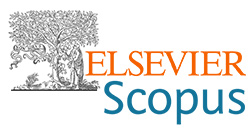Groundnut shell carbon quantum dot magnetic iron oxide nanocomposite (GSCQD-FeFe2O4) for lead removal from water
DOI:
https://doi.org/10.62638/ZasMat1185Abstract
A novel adsorbent, GSCQD-FeFe2O4, combining groundnut shell-derived carbon quantum dots with magnetic iron oxide nanoparticles, was synthesized for efficient removal of Pb(II) from water. Characterization studies confirmed successful synthesis, with UV analysis showing absorption at 210 nm and green luminescence indicating carbon quantum dots. FT-IR identified characteristic functional groups, while XRD confirmed well-ordered structures. FE-SEM revealed clustered carbon nanoparticles with magnetic iron oxide, and TEM showed small-sized carbon dots suitable for adsorption. Batch adsorption studies revealed optimal conditions for Pb(II) removal, including a pH range of 5-6, temperature of 20°C, contact time of 20 minutes, and adsorbent dose of 0.2 g. Isotherm studies indicated that both Langmuir and Freundlich models provided a good fit, with a calculated adsorption capacity of 37.8 mg/g. Thermodynamic analysis suggested spontaneous, exothermic adsorption with increased disorder. GSCQD-FeFe2O4 displayed excellent potential for Pb(II) removal, but further research on reusability and stability in industrial settings is needed for broader applicability.
Keywords:
carbon quantum dots, groundnut shell, magnetic iron oxide nanoparticle, lead, adsorption capacity, thermodynamic parameters, thermodynamic isothermsReferences
Briffa, J., E. Sinagra, and R. Blundell. "Heavy metal pollution in the environment and their toxicological effects on humans." Heliyon 6, no. 9 (2020): e0469. https://doi.org/10.1016/j.heliyon.2020.
Cimboláková, I., I. Uher, K. V. Laktičová, M. Vargová, T. Kimáková, and I. Papajová. "Heavy metals and the environment." Environmental Factors Affecting Human Health (2020). https://doi.org/10.5772/intechopen.86876.
Jaiswal, A., A. Verma, and P. Jaiswal. "Detrimental effects of heavy metals in soil, plants, aquatic ecosystems, and humans." Journal of Environmental Pathology, Toxicology and Oncology 37, no. 3 (2018): 183–197. https://doi.org/10.1615/JEnvironPatholToxicolOncol.2018025348.
Dehdashti, B., M. M. Amin, and A. Chavoshani. "Other trace elements (heavy metals) and chemicals." In Micropollutants Challenges: Emerging in the Aquatic Environments and Treatment Processes, p. 215. Elsevier. https://www.elsevier.com/books-and-journals.
Yu, Y. L., W. Y. Yang, A. Hara, K. Asayama, H. A. Roels, T. S. Nawrot, and J. A. Staessen. "Public and occupational health risks related to lead exposure updated according to present-day blood lead levels." Hypertension Research 46, no. 2 (2023): 395-407. https://doi.org/10.1038/s41440-022-01069-x.
Collin, M. S., S. K. Venkatraman, N. Vijayakumar, V. Kanimozhi, S. M. Arbaaz, R. S. Stacey, J. Anusha, R. Choudhary, V. Lvov, G. I. Tovar, and F. Senatov. "Bioaccumulation of lead (Pb) and its effects on humans: A review." Journal of Hazardous Materials Advances 7 (2022): 100094. https://doi.org/10.1016/j.hazadv.2022.100094.
Levallois, P., P. Barn, M. Valcke, D. Gauvin, and T. Kosatsky. "Public health consequences of lead in drinking water." Current Environmental Health Reports 5 (2018): 255-262. https://doi.org/10.1007/s40572-018-0193-0.
Mohanapriya, V., R. Sakthivel, N. D. K. Pham, C. K. Cheng, H. S. Le, and T. M. H. Dong. "Nanotechnology ray of hope for heavy metals removal." Chemosphere 311 (2023): 136989. https://doi.org/10.1016/j.chemosphere.2022.136989.
Ethaib, S., S. Al-Qutaifia, N. Al-Ansari, and S. L. Zubaidi. "Function of nanomaterials in removing heavy metals for water and wastewater remediation: A review." Environments 9, no. 10 (2022): 123. https://doi.org/10.3390/environments9100123.
Dhillon, A., and D. Kumar. "New generation nano-based adsorbents for water purification." In Nanoscale Materials in Water Purification, pp. 783-798. Elsevier, 2019. https://doi.org/10.1016/B978-0-12-813926-4.00036-7.
Farshbaf, M., S. Davaran, F. Rahimi, N. Annabi, R. Salehi, and A. Akbarzadeh. "Carbon quantum dots: Recent progress on synthesis, surface modification and applications." Artificial Cells, Nanomedicine, and Biotechnology 46, no. 7 (2018): 1331-1348. https://doi.org/10.1080/21691401.2017.1377725.
Matveeva, V. G., and L. M. Bronstein. "From renewable biomass to nanomaterials: Does biomass origin matter?" Progress in Materials Science 130 (2022): 100999. https://doi.org/10.1016/j.pmatsci.2022.100999.
Perumal, S., R. Atchudan, T. N. J. I. Edison, and Y. R. Lee. "Sustainable synthesis of multifunctional carbon dots using biomass and their applications: A mini-review." Journal of Environmental Chemical Engineering 9, no. 4 (2021): 105802. https://doi.org/10.1016/j.jece.2021.105802.
Surendran, P., A. Lakshmanan, G. Vinitha, G. Ramalingam, and P. Rameshkumar. "Facile preparation of high fluorescent carbon quantum dots from orange waste peels for nonlinear optical applications." Luminescence 35, no. 2 (2020): 196-202. https://doi.org/10.1002/bio.3713.
Dinh, V. P., N. Q. Tran, Q. H. Tran, and T. D. Nguyen. "Facile synthesis of FeFe2O4 magnetic nanomaterial for removing methylene blue from aqueous solution." Progress in Natural Science: Materials International 29, no. 6 (2019): 648-654. https://doi.org/10.1016/j.pnsc.2019.11.009.
Asadollahzadeh, H., M. Ghazizadeh, and M. Manzari. "Developing a magnetic nanocomposite adsorbent based on carbon quantum dots prepared from pomegranate peel for the removal of Pb(II) and Cd(II) ions from aqueous solution." Analytical Methods in Environmental Chemistry Journal 4, no. 3 (2021): 33-46. https://doi.org/10.24200/amecj.v4.i03.149.
Malacas, M., M. C. Balberan, N. A. Bederi, C. J. Ramos, M. Rato, A. G. Salazar, and E. Roque. "The removal of copper (II) and lead (II) from aqueous solution using Fuller’s earth and Fuller’s earth-immobilized nanoscale zero-valent iron (FE-NZVI) by adsorption." MATEC Web of Conferences 268 (2019): 05006. https://doi.org/10.1051/matecconf/201926805006.
Qiang, R., S. Yang, K. Hou, and J. Wang. "Synthesis of carbon quantum dots with green luminescence from potato starch." New Journal of Chemistry 43, no. 27 (2019): 10826-10833. https://doi.org/10.1039/C9NJ02291K.
Pritzl, S. D., F. Pschunder, F. Ehrat, S. Bhattacharyya, L. Lohmüller, M. A. Huergo, and J. Feldmann. "Trans-membrane fluorescence enhancement by carbon dots: Ionic interactions and energy transfer." Nano Letters 19, no. 6 (2019): 3886-3891. https://doi.org/10.1021/acs.nanolett.9b01071.
Huang, P., J. Lin, X. Wang, Z. Wang, C. Zhang, M. He, Q. Wang, F. Chen, Z. Li, G. Shen, and D. Cui. "Light-triggered theranostics based on photosensitizer-conjugated carbon dots for simultaneous enhanced-fluorescence imaging and photodynamic therapy." Advanced Materials 24, no. 37 (2012): 5104-5113. https://doi.org/10.1002/adma.201200650.
Abd Rani, U., L. Y. Ng, C. Y. Ng, and E. Mahmoudi. "A review of carbon quantum dots and their applications in wastewater treatment." Advances in Colloid and Interface Science 278 (2020): 102124. https://doi.org/10.1016/j.cis.2020.102124.
Banerjee, S. S., M. V. Joshi, and R. V. Jayaram. "Removal of Cr(VI) and Hg(II) from aqueous solutions using fly ash and impregnated fly ash." Separation Science and Technology 39, no. 7 (2005): 1611-1629. https://doi.org/10.1081/SS-120030778.
Zare, H., H. Heydarzade, M. Rahimnejad, A. Tardast, M. Seyfi, and S. M. Peyghambarzadeh. "Dried activated sludge as an appropriate biosorbent for the removal of copper(II) ions." Arabian Journal of Chemistry 8, no. 6 (2015): 858-864. https://doi.org/10.1016/j.arabjc.2012.11.019.
Günay, A., E. Arslankaya, and I. Tosun. "Lead removal from aqueous solution by natural and pretreated clinoptilolite: Adsorption equilibrium and kinetics." Journal of Hazardous Materials 146, no. 1-2 (2007): 362-371. https://doi.org/10.1016/j.jhazmat.2006.12.034.
Hosseini, S., M. A. Khan, M. R. Malekbala, W. Cheah, and T. S. Choong. "Carbon coated monolith, a mesoporous material for the removal of methyl orange from aqueous phase: Adsorption and desorption studies." Chemical Engineering Journal 171, no. 3 (2011): 1124-1131. https://doi.org/10.1016/j.cej.2011.05.010.
Teoh, Y. P., M. A. Khan, and T. S. Choong. "Kinetic and isotherm studies for lead adsorption from aqueous phase on carbon coated monolith." Chemical Engineering Journal 217 (2013): 248-255. https://doi.org/10.1016/j.cej.2012.12.013.
Kumar, P., and P. Kumar. "Removal of cadmium (Cd-II) from aqueous solution using gas industry-based adsorbent." SN Applied Sciences 1, no. 1 (2019): 1-8. https://doi.org/10.1007/s42452-019-0377-8.
Langmuir, I. "The adsorption of gases on plane surfaces of glass, mica and platinum." Journal of the American Chemical Society 40, no. 9 (1918): 1361-1403. https://doi.org/10.1021/ja02242a004.
Mohammadzadeh-Asl, S., A. Jafari, A. Aghanejad, H. Monirinasab, and J. E. N. Dolatabadi. "Kinetic and thermodynamic studies of sunitinib malate interaction with albumin using surface plasmon resonance and molecular docking methods." Microchemical Journal 150 (2019): 104089. https://doi.org/10.1016/j.microc.2019.104089.
Yadava, K. P., B. S. Tyagi, and V. N. Singh. "Effect of temperature on the removal of lead (II) by adsorption on China clay and wollastonite." Journal of Chemical Technology and Biotechnology 51, no. 1 (1991): 47-60. https://doi.org/10.1002/jctb.280510105.
Sahmoune, M. N. "Evaluation of thermodynamic parameters for adsorption of heavy metals by green adsorbents." Environmental Chemistry Letters 17, no. 2 (2019): 697-704. https://doi.org/10.1007/s10311-018-00819-z.
Hasan, M. M., M. S. Salman, M. N. Hasan, A. I. Rehan, M. E. Awual, A. I. Rasee, R. M. Waliullah, M. S. Hossain, K. T. Kubra, M. C. Sheikh, and M. A. Khaleque. "Facial conjugate adsorbent for sustainable Pb (II) ion monitoring and removal from contaminated water." Colloids and Surfaces A: Physicochemical and Engineering Aspects 673 (2023): 131794. https://doi.org/10.1016/j.colsurfa.2023.131794.
Bidhendi, M. E., E. Parandi, M. M. Meymand, H. Sereshti, H. R. Nodeh, S. W. Joo, Y. Vasseghian, N. M. Khatir, and S. Rezania. "Removal of lead ions from wastewater using magnesium sulfide nanoparticles caged alginate microbeads." Environmental Research 216 (2023): 114416. https://doi.org/10.1016/j.envres.2022.114416.
Zadeh, K. K., and D. Jafari. "Activated carbon/alginate/Fe3O4 magnetic nanocomposite as a superior functional material for removal of lead from aqueous media." Biomass Conversion and Biorefinery (2023): 1-19. https://doi.org/10.1007/s13399-023-04040-z.
Al-Yaari, M., and T. A. Saleh. "Removal of lead from wastewater using synthesized polyethylene-imine-grafted graphene oxide." Nanomaterials 13, no. 6 (2023): 1078. https://doi.org/10.3390/nano13061078.
Mahar, I., F. K. Mahar, N. Mahar, A. A. Memon, A. A. A. Pirzado, Z. Khatri, K. H. Thebo, and A. Ali. "Fabrication and characterization of MXene/carbon composite-based nanofibers (MXene/CNFs) membrane: An efficient adsorbent material for removal of Pb+2 and As+3 ions from water." Chemical Engineering Research and Design 191 (2023): 462-471. https://doi.org/10.1016/j.cherd.2023.02.005.







